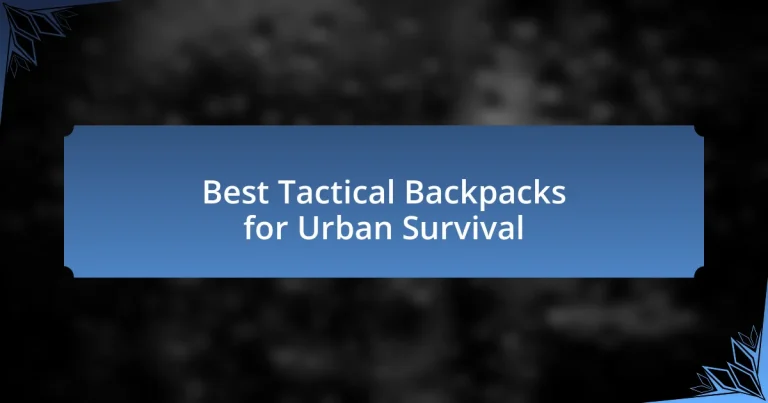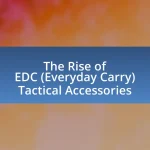Tactical backpacks for urban survival are specialized bags designed to carry essential gear in emergency situations within urban environments. These backpacks are characterized by durable materials, multiple compartments for organization, and features like MOLLE webbing for enhanced functionality. The article explores the differences between tactical and regular backpacks, key features that make a backpack tactical, and the importance of these features for urban survival. It also discusses the ideal size and capacity for urban scenarios, materials that impact durability, and top recommended models and brands. Additionally, practical tips for effective use and maintenance of tactical backpacks are provided, ensuring users are well-prepared for urban challenges.
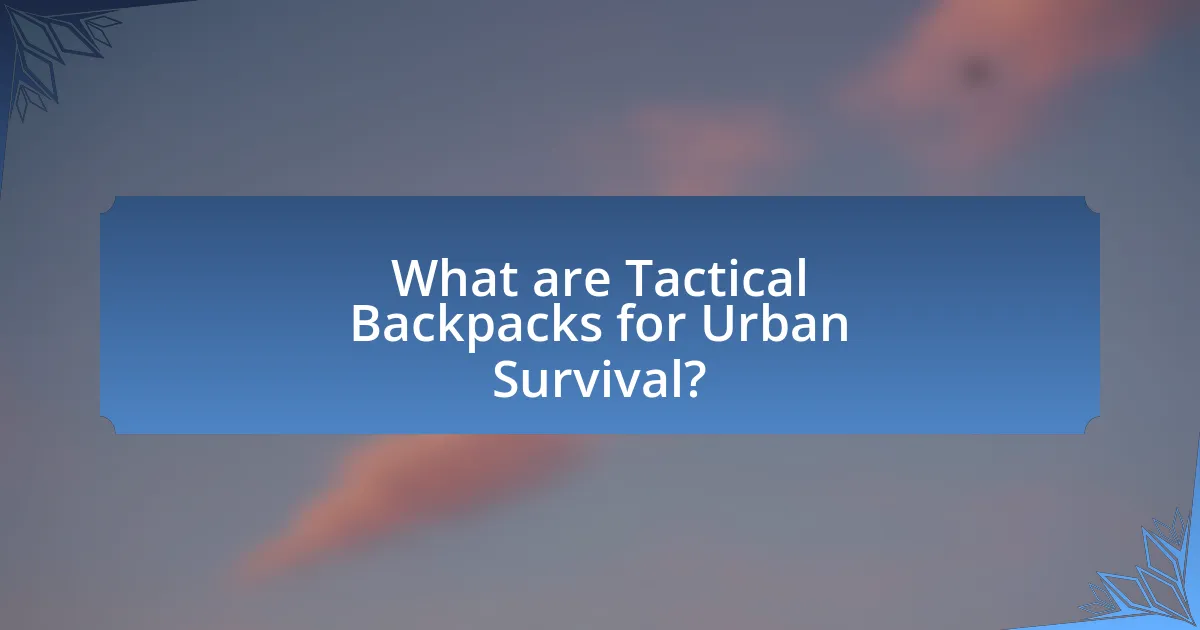
What are Tactical Backpacks for Urban Survival?
Tactical backpacks for urban survival are specialized bags designed to carry essential gear and supplies in urban environments during emergencies or survival situations. These backpacks typically feature durable materials, multiple compartments for organization, and accessibility for quick retrieval of items. They often include MOLLE (Modular Lightweight Load-carrying Equipment) webbing for attaching additional pouches and gear, enhancing their functionality. The design of tactical backpacks prioritizes comfort and support, with padded straps and back panels, making them suitable for extended wear in urban settings.
How do Tactical Backpacks differ from regular backpacks?
Tactical backpacks differ from regular backpacks primarily in their design and functionality, emphasizing durability, organization, and versatility. Tactical backpacks are constructed from high-denier nylon or polyester, making them more resistant to wear and tear compared to the materials typically used in regular backpacks. Additionally, tactical backpacks feature multiple compartments, MOLLE (Modular Lightweight Load-carrying Equipment) webbing for attaching extra gear, and often include specialized pockets for tools, hydration systems, and electronics, which are not commonly found in standard backpacks. These features cater to users who require efficient gear management and quick access to essential items, such as military personnel, outdoor enthusiasts, or emergency responders.
What features make a backpack tactical?
A tactical backpack is characterized by features that enhance functionality, durability, and versatility for various situations. Key features include heavy-duty materials such as nylon or polyester for weather resistance, multiple compartments for organized storage, and MOLLE (Modular Lightweight Load-carrying Equipment) webbing for attaching additional gear. These backpacks often have padded shoulder straps and back panels for comfort during extended wear, as well as hydration reservoir compatibility for easy access to water. The inclusion of reinforced stitching and zippers ensures longevity under demanding conditions. These features collectively make tactical backpacks suitable for urban survival scenarios, where adaptability and reliability are crucial.
Why are these features important for urban survival?
The features of tactical backpacks are crucial for urban survival because they enhance mobility, organization, and preparedness in unpredictable environments. Mobility is essential in urban settings where quick movement can be necessary for safety; tactical backpacks often include ergonomic designs and lightweight materials that facilitate this. Organization is vital as urban survival may require carrying various tools and supplies; these backpacks typically have multiple compartments and pockets that allow for efficient storage and easy access to essential items. Preparedness is critical in emergencies, and tactical backpacks often come equipped with features such as hydration systems, first aid kits, and durable materials that withstand harsh conditions. These attributes collectively ensure that individuals are equipped to respond effectively to urban challenges, as evidenced by studies showing that well-prepared individuals are more likely to navigate crises successfully.
What are the key benefits of using Tactical Backpacks in urban environments?
Tactical backpacks offer several key benefits in urban environments, including durability, organization, and versatility. Their robust materials withstand wear and tear from daily use, making them ideal for city life. Additionally, these backpacks often feature multiple compartments and pockets, allowing users to efficiently organize gear, tools, and personal items, which is essential for quick access in fast-paced urban settings. Furthermore, tactical backpacks are designed for adaptability, accommodating various activities such as commuting, hiking, or emergency preparedness, thus enhancing their utility in diverse urban scenarios.
How do Tactical Backpacks enhance mobility and accessibility?
Tactical backpacks enhance mobility and accessibility by incorporating ergonomic designs, lightweight materials, and multiple carrying options. These features allow users to move quickly and efficiently in various environments, whether urban or wilderness. For instance, many tactical backpacks include adjustable straps and padded backs that distribute weight evenly, reducing fatigue during extended use. Additionally, the presence of multiple compartments and external attachment points facilitates easy access to gear, enabling users to retrieve items without having to remove the backpack. This design is particularly beneficial in urban survival scenarios, where quick access to tools or supplies can be crucial.
What role do Tactical Backpacks play in emergency preparedness?
Tactical backpacks play a crucial role in emergency preparedness by providing organized storage for essential gear and supplies. These backpacks are designed with multiple compartments and durable materials, allowing individuals to carry items such as first aid kits, food, water, and tools efficiently. Their ergonomic design ensures comfort during extended use, which is vital in emergency situations where mobility is key. Additionally, tactical backpacks often feature MOLLE (Modular Lightweight Load-carrying Equipment) systems, enabling users to customize their loadout based on specific needs, enhancing overall preparedness.
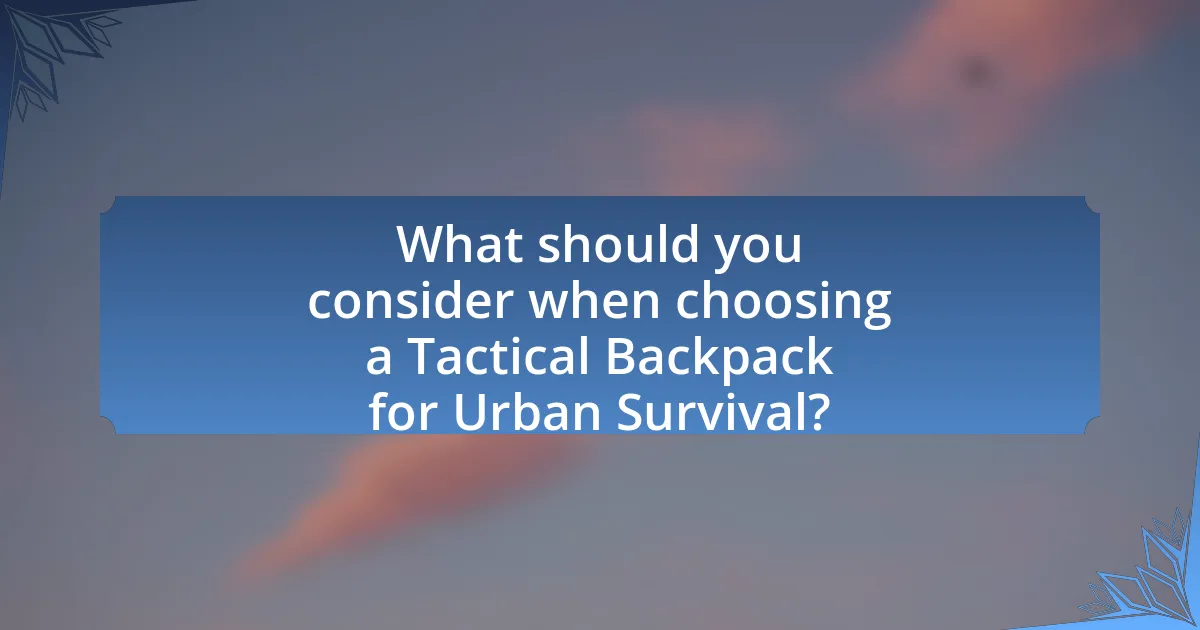
What should you consider when choosing a Tactical Backpack for Urban Survival?
When choosing a Tactical Backpack for Urban Survival, consider durability, capacity, organization, and comfort. Durability ensures the backpack can withstand harsh conditions, often indicated by materials like 1000D nylon or reinforced stitching. Capacity should align with your needs, typically ranging from 20 to 50 liters for urban environments, allowing for essential gear without being cumbersome. Organization features, such as multiple compartments and MOLLE webbing, facilitate easy access to tools and supplies. Comfort is crucial for extended wear, so look for padded shoulder straps and a breathable back panel to enhance usability during urban survival scenarios.
What size and capacity are ideal for urban survival scenarios?
The ideal size for urban survival backpacks is typically between 20 to 40 liters. This capacity allows for sufficient storage of essential gear without being overly cumbersome in crowded environments. A 20 to 30-liter backpack is suitable for day trips, while a 30 to 40-liter option can accommodate additional supplies for longer durations. This range is supported by survival experts who emphasize the importance of mobility and accessibility in urban settings, where quick movement is often necessary.
How does the size affect the backpack’s usability in urban settings?
The size of a backpack significantly impacts its usability in urban settings by determining its capacity for carrying essential items while maintaining comfort and maneuverability. A smaller backpack allows for easier navigation through crowded spaces, such as public transport and busy streets, while a larger backpack can accommodate more gear but may hinder mobility and become cumbersome. Research indicates that backpacks with a capacity of 20 to 30 liters are optimal for urban environments, as they provide sufficient space for daily necessities without overwhelming the user. This balance between size and usability is crucial for effective urban survival, as it enables individuals to remain agile and responsive to their surroundings.
What capacity is necessary for essential gear and supplies?
A capacity of 20 to 40 liters is necessary for essential gear and supplies in urban survival tactical backpacks. This range allows for adequate storage of critical items such as food, water, first aid kits, and personal defense tools while remaining manageable for mobility. Research indicates that backpacks within this capacity can effectively balance weight and volume, ensuring that users can carry essential gear without excessive strain, which is crucial in urban environments where agility is often required.
What materials and construction features are important?
Durable materials and robust construction features are essential for tactical backpacks designed for urban survival. High-denier nylon or polyester fabrics provide resistance to wear and tear, while water-resistant coatings enhance protection against the elements. Reinforced stitching and heavy-duty zippers ensure longevity and reliability under stress. Additionally, features such as multiple compartments, MOLLE webbing for modular attachments, and padded shoulder straps contribute to functionality and comfort, making these backpacks suitable for various urban scenarios. These specifications are critical for ensuring that the backpack can withstand the demands of urban environments while providing easy access to essential gear.
How do different materials impact durability and weather resistance?
Different materials significantly impact the durability and weather resistance of tactical backpacks. For instance, nylon and polyester are commonly used due to their high tensile strength and resistance to abrasion, making them durable under various conditions. Additionally, materials like Cordura nylon offer enhanced resistance to tears and punctures, which is crucial for urban survival scenarios. Weather resistance is often improved through coatings such as polyurethane or silicone, which provide water repellency and protect against moisture. According to a study by the American Society for Testing and Materials, fabrics treated with these coatings can withstand water pressure up to 1,000 mm, indicating their effectiveness in wet conditions. Thus, the choice of material directly influences both the longevity and protective capabilities of tactical backpacks in diverse environments.
What construction features enhance comfort and support?
Construction features that enhance comfort and support in tactical backpacks include ergonomic design, adjustable straps, and padded back panels. Ergonomic design ensures that the backpack conforms to the body’s natural shape, reducing strain during extended wear. Adjustable straps allow for a customized fit, accommodating various body types and ensuring weight distribution is optimized. Padded back panels provide cushioning and ventilation, enhancing comfort by reducing pressure points and allowing airflow to keep the user cool. These features collectively contribute to a more comfortable and supportive experience, essential for urban survival scenarios where mobility and endurance are critical.
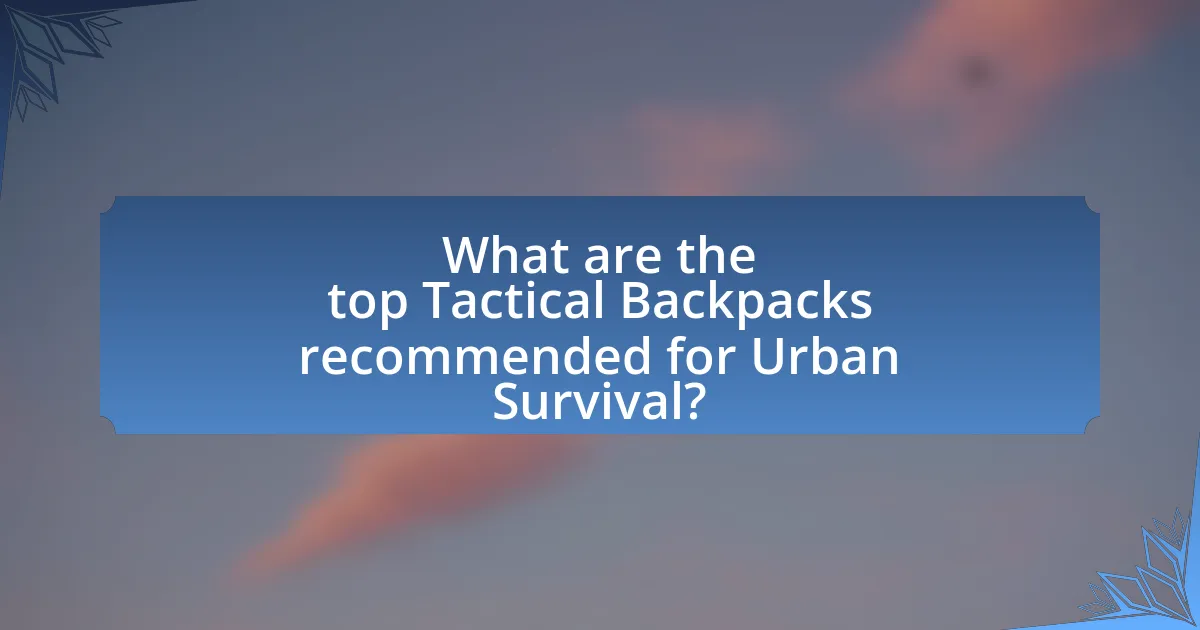
What are the top Tactical Backpacks recommended for Urban Survival?
The top tactical backpacks recommended for urban survival include the 5.11 Tactical Rush 24, the Maxpedition Falcon-II, and the Condor 3-Day Assault Pack. The 5.11 Tactical Rush 24 is known for its durability and ample storage, featuring a 37-liter capacity and multiple compartments for organization. The Maxpedition Falcon-II offers a compact design with a 23-liter capacity, making it suitable for everyday carry while maintaining functionality. The Condor 3-Day Assault Pack is recognized for its spacious 50-liter capacity and robust construction, ideal for extended urban excursions. These backpacks are favored for their resilience, organization, and adaptability in urban environments.
What are the best brands known for Tactical Backpacks?
The best brands known for tactical backpacks include 5.11 Tactical, Maxpedition, and Condor. 5.11 Tactical is recognized for its durable and functional designs, often used by law enforcement and military personnel. Maxpedition is celebrated for its high-quality materials and modular designs, catering to outdoor enthusiasts and survivalists. Condor offers a range of affordable yet reliable tactical backpacks, making it a popular choice among budget-conscious consumers. These brands are consistently rated highly for their performance, durability, and practicality in various tactical and survival scenarios.
What specific models are highly rated for urban survival?
Highly rated models for urban survival include the 5.11 Tactical Rush 24, the Maxpedition Falcon II, and the Vertx Gamut 2.0. The 5.11 Tactical Rush 24 is praised for its durability and ample storage, featuring a 37-liter capacity and multiple compartments for organization. The Maxpedition Falcon II is recognized for its versatility and comfort, equipped with a 23-liter capacity and a hydration compartment. The Vertx Gamut 2.0 stands out for its discreet design and functionality, offering a 24-liter capacity and a quick-access pocket for essential items. These models are consistently recommended in survival gear reviews for their reliability and practicality in urban environments.
What unique features do these models offer?
These tactical backpacks for urban survival offer unique features such as modular attachment systems, water-resistant materials, and multiple compartments for organization. Modular attachment systems, like MOLLE (Modular Lightweight Load-carrying Equipment), allow users to customize their backpack by adding pouches or gear, enhancing versatility. Water-resistant materials ensure that contents remain dry in adverse weather conditions, which is crucial for urban survival scenarios. Additionally, multiple compartments facilitate efficient organization of gear, making it easier to access essential items quickly. These features collectively enhance the functionality and adaptability of the backpacks in urban environments.
How do user reviews and expert opinions influence backpack selection?
User reviews and expert opinions significantly influence backpack selection by providing insights into product performance and user satisfaction. Consumers often rely on user reviews to gauge the durability, comfort, and functionality of backpacks, as these firsthand experiences can highlight potential issues or advantages that may not be evident in product descriptions. For instance, a study by BrightLocal in 2020 found that 79% of consumers trust online reviews as much as personal recommendations, indicating the weight user feedback carries in decision-making. Expert opinions, such as those from outdoor gear reviewers or industry professionals, further enhance credibility by offering informed assessments based on testing and experience. This combination of user and expert feedback helps potential buyers make informed choices, ultimately shaping their selection of tactical backpacks for urban survival.
What common praises and complaints do users have about popular models?
Users commonly praise popular tactical backpacks for their durability, ample storage capacity, and organizational features, which enhance usability in urban survival scenarios. For instance, many users highlight the robust materials used in construction, such as 1000D nylon, which withstands wear and tear. Conversely, complaints often center around the weight of these backpacks, with some users finding them cumbersome when fully loaded. Additionally, issues with comfort, particularly regarding padding and fit, are frequently mentioned, as users seek a balance between carrying capacity and ease of transport.
How can expert recommendations guide your choice?
Expert recommendations can significantly guide your choice of tactical backpacks for urban survival by providing insights based on experience and knowledge of the product’s performance in real-world scenarios. Experts often evaluate various features such as durability, capacity, and functionality, which are critical for urban survival situations. For instance, a review by OutdoorGearLab highlighted that backpacks with reinforced stitching and water-resistant materials are essential for urban environments, ensuring longevity and protection against the elements. Additionally, expert recommendations often include comparisons of different models, helping consumers make informed decisions based on specific needs, such as weight distribution and accessibility of compartments. This evidence-based guidance can lead to more satisfactory purchases that align with survival requirements.
What are some practical tips for using Tactical Backpacks effectively?
To use tactical backpacks effectively, prioritize organization by utilizing compartments and pouches for easy access to gear. This method enhances efficiency during urban survival situations, allowing quick retrieval of essential items like first aid kits or tools. Additionally, adjust the straps for a snug fit to distribute weight evenly, which reduces fatigue during extended use. Research indicates that proper weight distribution can improve endurance and comfort, making it crucial for long-term carrying. Lastly, regularly assess and update the contents based on changing needs or environments to ensure preparedness for various scenarios.
How can you organize your gear for quick access?
To organize your gear for quick access, utilize a systematic approach by categorizing items based on frequency of use and function. Place frequently used items, such as first aid kits and multi-tools, in easily accessible compartments or external pockets of the tactical backpack. For example, a study by the American Journal of Emergency Medicine highlights that having immediate access to first aid supplies can significantly reduce response time in emergencies. Additionally, use color-coded pouches or labels to quickly identify specific gear, enhancing efficiency during critical situations. This method ensures that essential items are readily available, improving overall preparedness in urban survival scenarios.
What maintenance practices ensure longevity of your Tactical Backpack?
Regular cleaning, proper storage, and timely repairs ensure the longevity of your tactical backpack. Cleaning involves removing dirt and debris after each use, typically with a damp cloth or sponge, and using mild soap for deeper cleans. Proper storage requires keeping the backpack in a cool, dry place away from direct sunlight to prevent material degradation. Timely repairs, such as sewing up small tears and replacing damaged buckles or zippers, help maintain the structural integrity of the backpack. These practices are essential as they prevent wear and tear, extending the lifespan of the backpack significantly.
